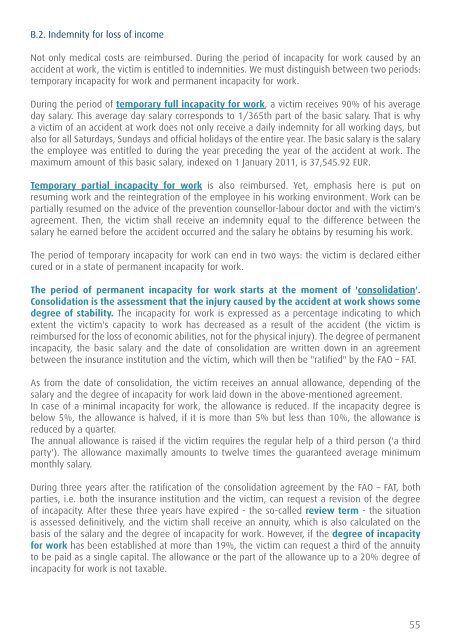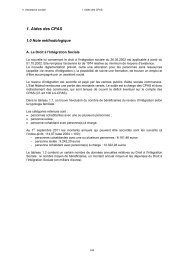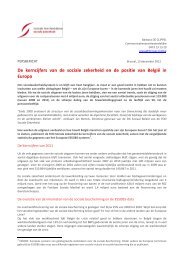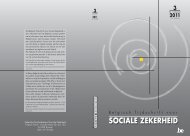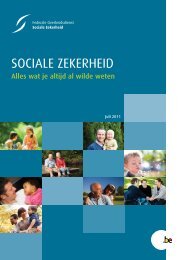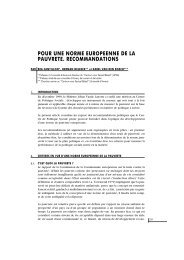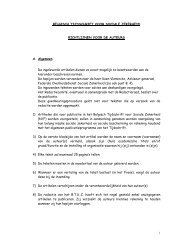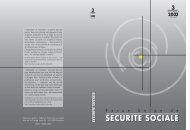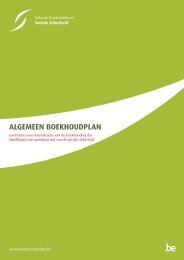social security - FOD Sociale Zekerheid
social security - FOD Sociale Zekerheid
social security - FOD Sociale Zekerheid
- No tags were found...
You also want an ePaper? Increase the reach of your titles
YUMPU automatically turns print PDFs into web optimized ePapers that Google loves.
B.2. Indemnity for loss of incomeNot only medical costs are reimbursed. During the period of incapacity for work caused by anaccident at work, the victim is entitled to indemnities. We must distinguish between two periods:temporary incapacity for work and permanent incapacity for work.During the period of temporary full incapacity for work, a victim receives 90% of his averageday salary. This average day salary corresponds to 1/365th part of the basic salary. That is whya victim of an accident at work does not only receive a daily indemnity for all working days, butalso for all Saturdays, Sundays and official holidays of the entire year. The basic salary is the salarythe employee was entitled to during the year preceding the year of the accident at work. Themaximum amount of this basic salary, indexed on 1 January 2011, is 37,545.92 EUR.Temporary partial incapacity for work is also reimbursed. Yet, emphasis here is put onresuming work and the reintegration of the employee in his working environment. Work can bepartially resumed on the advice of the prevention counsellor-labour doctor and with the victim'sagreement. Then, the victim shall receive an indemnity equal to the difference between thesalary he earned before the accident occurred and the salary he obtains by resuming his work.The period of temporary incapacity for work can end in two ways: the victim is declared eithercured or in a state of permanent incapacity for work.The period of permanent incapacity for work starts at the moment of 'consolidation'.Consolidation is the assessment that the injury caused by the accident at work shows somedegree of stability. The incapacity for work is expressed as a percentage indicating to whichextent the victim's capacity to work has decreased as a result of the accident (the victim isreimbursed for the loss of economic abilities, not for the physical injury). The degree of permanentincapacity, the basic salary and the date of consolidation are written down in an agreementbetween the insurance institution and the victim, which will then be "ratified" by the FAO – FAT.As from the date of consolidation, the victim receives an annual allowance, depending of thesalary and the degree of incapacity for work laid down in the above-mentioned agreement.In case of a minimal incapacity for work, the allowance is reduced. If the incapacity degree isbelow 5%, the allowance is halved, if it is more than 5% but less than 10%, the allowance isreduced by a quarter.The annual allowance is raised if the victim requires the regular help of a third person ('a thirdparty'). The allowance maximally amounts to twelve times the guaranteed average minimummonthly salary.During three years after the ratification of the consolidation agreement by the FAO – FAT, bothparties, i.e. both the insurance institution and the victim, can request a revision of the degreeof incapacity. After these three years have expired - the so-called review term - the situationis assessed definitively, and the victim shall receive an annuity, which is also calculated on thebasis of the salary and the degree of incapacity for work. However, if the degree of incapacityfor work has been established at more than 19%, the victim can request a third of the annuityto be paid as a single capital. The allowance or the part of the allowance up to a 20% degree ofincapacity for work is not taxable.55


